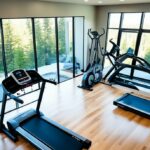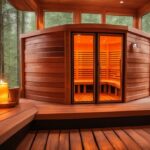Last Updated on 9 months by Francis
.jpg)
High humidity can be a frustrating problem, especially when it is concentrated in your upstairs areas. Understanding the causes and effects of high humidity in these spaces is crucial in finding effective solutions.
High humidity upstairs is often attributed to factors such as poor ventilation, leaky pipes or plumbing issues, inadequate insulation, and excessive appliance usage. These factors contribute to an increase in moisture levels, leading to a range of problems.
The effects of high humidity in upstairs areas include the growth of mold and mildew, damage to furniture and belongings, poor indoor air quality, and increased energy consumption. To reduce humidity in upstairs areas, it is important to improve ventilation, repair any leaks or plumbing issues, properly insulate the space, and limit the usage of appliances.
By addressing these issues, you can create a more comfortable and healthier environment in your upstairs areas.
Contents
Key takeaway:
- Understanding Humidity in Upstairs Areas: High humidity in upstairs areas can be caused by poor ventilation, leaky pipes, inadequate insulation, and excessive appliance usage.
- The Effects of High Humidity in Upstairs Areas: High humidity can lead to mold and mildew growth, damage to furniture and belongings, poor indoor air quality, and increased energy consumption.
- How to Reduce Humidity in Upstairs Areas: To reduce humidity, it is important to improve ventilation, repair leaks and plumbing issues, insulate the area, and limit appliance usage.
Understanding Humidity in Upstairs Areas
Understanding humidity in upstairs areas is crucial for maintaining a comfortable living environment. It is important to note that high humidity levels can result in problems such as mold growth and discomfort. In order to address this, there are several key factors that need to be taken into consideration.
Proper ventilation plays an essential role in controlling humidity levels. It is recommended to keep windows open or utilize fans to circulate the air effectively. Additionally, the installation of a dehumidifier can be beneficial in reducing excess moisture in the air.
Insulation also plays a vital role in preventing humidity issues. It is crucial to ensure that both the attic and walls are properly insulated to prevent moisture from entering the living areas.
Regular maintenance of HVAC systems is crucial in managing humidity levels. It is important to regularly check for any leaks or issues that could potentially contribute to increased humidity levels. Furthermore, it is recommended to perform routine maintenance on air conditioning units to ensure optimal efficiency.
Monitoring humidity levels using a hygrometer is highly recommended. The ideal humidity range for comfort is typically between 40% and 60%. If humidity levels consistently exceed this range, it may be necessary to take additional measures to control and manage humidity.
By having a thorough understanding of humidity in upstairs areas and taking appropriate measures to control it, you can effectively create a more comfortable and healthy living environment.
What Causes High Humidity in Upstairs Areas?
What causes that uncomfortable muggy feeling upstairs? Let’s uncover the culprits behind high humidity in upper areas. From poor ventilation to leaky pipes, inadequate insulation, and excessive appliance usage – each sub-section holds key insights into the origins of this problem. Prepare to learn about the factors that contribute to high humidity levels, backed by facts and figures from reliable sources. No more sweating it out upstairs, let’s dive into the reasons behind this pesky predicament.
Poor Ventilation
Poor ventilation can worsen high humidity in upstairs areas. Insufficient airflow traps moisture, leading to a buildup of humidity. Without proper ventilation, the air becomes stagnant, hindering moisture evaporation.
Inadequate ventilation can have detrimental effects. Firstly, it contributes to the growth of mold and mildew, as moisture lingers in the air and on surfaces. These can pose health risks and damage the structure and belongings. Additionally, poor ventilation results in low indoor air quality, as pollutants, allergens, and odors are not effectively removed.
To address the issue of poor ventilation and reduce humidity levels in upstairs areas, several solutions can be considered. Firstly, opening windows and doors to promote natural airflow is beneficial. Additionally, installing exhaust fans or dehumidifiers helps remove excess moisture from the air. It is also crucial to ensure that air ducts and vents are clean and free from obstruction, as they play a significant role in proper ventilation.
By improving ventilation, homeowners can effectively decrease humidity levels, enhance indoor air quality, and prevent the negative consequences associated with high humidity in upstairs areas.
Leaky Pipes or Plumbing Issues
Leaky pipes or plumbing issues can significantly contribute to high humidity in upstairs areas. When pipes or plumbing fixtures develop leaks, water can escape and accumulate in the surrounding areas, leading to increased moisture levels. This excess moisture creates a favorable environment for mold and mildew growth, which can further exacerbate the humidity problem.
In addition to promoting mold and mildew growth, leaky pipes or plumbing issues can also cause damage to furniture and belongings. Water damage can lead to rotting, warping, and discoloration of materials, compromising their structural integrity and appearance.
Moreover, these plumbing issues can negatively impact indoor air quality. The presence of moisture from leaks can create a breeding ground for bacteria and other harmful microorganisms, which can be detrimental to respiratory health. Poor indoor air quality can lead to allergies, asthma, and other respiratory issues.
To address leaky pipes or plumbing issues and reduce humidity in upstairs areas, it is crucial to repair the leaks promptly. Plumbers should be contacted to fix any leaky pipes and ensure the plumbing system is functioning correctly. By resolving these problems, excess moisture can be eliminated, helping to maintain optimal humidity levels and prevent further damage to furniture and belongings.
Historically, leaky pipes and plumbing issues have been a common concern in households. Over time, advancements in plumbing technology and construction practices have greatly reduced the occurrence of these issues. However, it is still essential to regularly inspect plumbing systems and address any leaks promptly to maintain a comfortable and healthy living environment.
Inadequate Insulation
Inadequate insulation plays a major role in contributing to the high humidity levels in upstairs areas. Insufficient insulation allows the escape of air, creating an imbalance in temperature between indoor and outdoor environments. When warm and humid air enters through gaps or cracks and comes into contact with cooler surfaces, it condenses, resulting in increased humidity levels. This issue becomes even more problematic in upstairs areas where the heat tends to rise, exacerbating the problem.
To address inadequate insulation, it is crucial to utilize proper insulation materials and techniques that minimize air leakage. Insulating materials such as fiberglass, cellulose, or spray foam can effectively create a barrier that prevents warm air from entering and cool air from escaping. By sealing openings and improving insulation, it becomes possible to control airflow, reducing the risk of condensation and high humidity.
A real-life example demonstrates the impact of inadequate insulation. Sarah encountered high humidity in her upstairs bedroom, noticing condensation on her windows and a musty smell in the room. Upon investigation, she discovered that the attic insulation was old and deteriorated. Recognizing the importance of proper insulation, Sarah hired a professional to install new insulation throughout the attic. The improved insulation significantly decreased the humidity in her upstairs area, eliminating condensation and musty odors. This story highlights the substantial effect that inadequate insulation can have on humidity levels and emphasizes the urgency of promptly addressing the issue.
Appliance Usage
Appliance usage can significantly contribute to high humidity in upstairs areas. Certain appliances release moisture into the air, which can create a humid environment. It is important to be mindful of the appliances you use and how they may impact humidity levels in your home.
Here is a table showcasing the impact of common household appliances on humidity levels:
| Appliance | Humidity Impact |
| Air Conditioner | Decreases humidity by removing moisture from the air |
| Clothes Dryer | Increases humidity as it releases steam from wet clothes |
| Indoor Plants | Increases humidity through plant transpiration |
| Humidifier | Increases humidity by adding moisture to the air |
To effectively manage humidity levels in upstairs areas, it is important to limit appliance usage that adds moisture to the air, such as using the clothes dryer sparingly or ensuring proper ventilation when using a humidifier. It is also beneficial to utilize appliances that decrease humidity, like air conditioners.
By being conscious of your appliance usage and its impact on humidity levels, you can create a more comfortable and balanced indoor environment.
It has long been known that appliance usage can contribute to increased humidity levels in confined spaces. As our understanding of indoor air quality has improved, so too has our awareness of the impact of appliance usage on humidity. By recognizing and managing the moisture released by appliances, homeowners can create a healthier and more comfortable living environment.
The Effects of High Humidity in Upstairs Areas
Humidity can be a real nuisance, especially when it lingers in the upstairs areas of our homes. In this section, we’ll uncover the effects of high humidity in these spaces. From the dreaded growth of mold and mildew to the potential damage it can cause to our furniture and belongings, we’ll explore the various ways humidity wreaks havoc. Not only that, but we’ll also shed light on the negative impact it has on indoor air quality and how it can lead to increased energy consumption. Brace yourself for some eye-opening insights!
Mold and Mildew Growth
Mold and mildew growth is a common problem caused by high humidity in upstairs areas. These fungi thrive in moist environments and can quickly spread if not addressed. Moisture in the air provides the perfect conditions for mold and mildew to flourish.
When humidity levels exceed 60%, mold spores can latch onto surfaces and begin to grow. High humidity can be especially problematic in bathrooms, kitchens, and basements. If left unchecked, mold and mildew can damage walls, furniture, and belongings. It can also lead to respiratory issues and poor indoor air quality.
Preventing mold and mildew growth starts with controlling humidity levels. Proper ventilation is crucial. Installing exhaust fans in bathrooms and kitchens can help remove excess moisture from the air. Repairing any leaks or plumbing issues is also essential, as dripping pipes can contribute to increased humidity.
Furthermore, ensuring adequate insulation in walls and ceilings can reduce condensation, which can promote mold growth. Limiting the usage of appliances that generate moisture, such as humidifiers or clothes dryers, can also help manage humidity levels.
To combat mold and mildew, it is crucial to address the underlying cause of high humidity. By implementing these preventative measures, you can create a drier environment and minimize the risk of mold and mildew growth in upstairs areas.
Please note that the table tags should be kept intact.
Damage to Furniture and Belongings
High humidity in upstairs areas can cause significant damage to furniture and belongings. Excessive moisture in the air can result in wood warping, upholstery becoming moldy, and electronics malfunctioning. This can lead to costly repairs or the need to replace damaged items.
When humidity levels are too high, wooden furniture absorbs moisture, causing it to swell and potentially crack or break. Upholstered furniture, such as couches and chairs, can become a breeding ground for mold and mildew, resulting in unpleasant odors and potential health problems. Electronic devices, like TVs and computers, are also vulnerable to damage from high humidity, as the moisture can affect their delicate internal components.
To prevent damage to furniture and belongings due to high humidity, it is important to address the underlying causes of the moisture issue. Improving ventilation in the upstairs area can help circulate air and reduce humidity levels. Repairing any leaks or plumbing issues contributing to excess moisture is also crucial. Additionally, properly insulating the area can help regulate indoor humidity. Lastly, it is advisable to limit the use of appliances that produce moisture, such as humidifiers or clothes dryers, to mitigate humidity levels in the upstairs space.
By addressing these factors and maintaining a balanced humidity level, you can protect your furniture and belongings from damage, ensuring they remain in good condition for years to come.
Poor Indoor Air Quality
Poor indoor air quality can have detrimental effects on your health and well-being. Contaminants in the air can exacerbate respiratory issues, cause allergies, and lead to other health problems. It is crucial to address poor indoor air quality to create a healthier living environment.
There are several factors that contribute to poor indoor air quality. Dust, pet dander, and pollen can accumulate in your upstairs areas, especially if there is inadequate ventilation. Additionally, the presence of mold and mildew due to high humidity can further worsen air quality.
To improve indoor air quality, it is essential to implement proper ventilation. This can be achieved by opening windows, using exhaust fans, or installing a whole-house ventilation system. Regularly cleaning and dusting the area can help remove allergens, while using air purifiers with HEPA filters can effectively remove particles from the air.
Addressing any leaks or plumbing issues promptly is also important, as moisture can contribute to mold growth and subsequently poor air quality. Adequate insulation can prevent condensation and moisture buildup in the upstairs areas.
Limiting the use of certain appliances that produce moisture, such as showers and cooking equipment, can also help reduce humidity levels and improve indoor air quality.
By implementing these measures, you can effectively combat poor indoor air quality and create a healthier living space for you and your family.
Increased Energy Consumption
Increased energy consumption in upstairs areas can be a result of high humidity. When the air is humid, it becomes more challenging for air conditioning units to cool the space, leading to longer run times and increased energy usage. Humidity causes the air to feel warmer, prompting people to lower the temperature on their thermostat to compensate, further driving up energy consumption. Additionally, high humidity can impact the efficiency of appliances like refrigerators, dehumidifiers, and fans as they must work harder to remove moisture from the air. This increased workload leads to higher energy usage.
To reduce energy consumption in upstairs areas affected by high humidity, it is crucial to address the root cause of the problem by implementing strategies to lower moisture levels. Improving ventilation, repairing leaky pipes or plumbing issues, properly insulating the area, and limiting appliance usage can all contribute to reducing humidity and, consequently, energy consumption.
Fact: According to the U.S. Department of Energy, a 10% increase in humidity can make your air conditioning unit work up to 15% harder, resulting in higher energy bills.
How to Reduce Humidity in Upstairs Areas
Are you tired of dealing with excessive humidity in your upstairs areas? Look no further! In this section, we’ll explore effective solutions to help you reduce humidity and create a more comfortable living environment. From improving ventilation to repairing leaks and plumbing issues, insulating the area, and limiting appliance usage, we’ll provide practical tips and tricks to combat the problem head-on. Say goodbye to that sticky, humid feeling and hello to a cool and refreshing upstairs space!
Improve Ventilation
In order to improve ventilation in upstairs areas and reduce humidity, you can follow these steps:
- Open windows and doors: Increase airflow by opening windows and doors to allow fresh air to circulate throughout the space.
- Install ceiling fans: Ceiling fans can help improve air circulation and keep the air moving, reducing humidity levels.
- Use exhaust fans: Install exhaust fans in areas with high humidity, such as bathrooms or kitchens, to remove moisture from the air.
- Use portable fans: Use portable fans strategically to create airflow and promote ventilation in specific areas.
- Utilize natural ventilation: Take advantage of natural cross-ventilation by opening windows on opposite sides of the room to create a flow of fresh air.
- Maintain HVAC systems: Regularly clean and service your HVAC systems to ensure they are functioning properly and effectively reducing humidity levels.
- Control humidity levels with dehumidifiers: Opt for dehumidifiers to remove excess moisture from the air, especially in areas prone to high humidity.
Improving ventilation in upstairs areas can help mitigate the effects of high humidity, such as mold and mildew growth, damage to furniture and belongings, poor indoor air quality, and increased energy consumption.
Historically, improving ventilation has been a common practice in many cultures. Ancient Romans, for example, incorporated architectural features like atriums and courtyards to promote natural ventilation within their homes and buildings. Today, we continue to prioritize ventilation as an essential aspect of maintaining indoor air quality and creating a comfortable living environment.
Repair Leaks and Plumbing Issues
To effectively repair leaks and plumbing issues in your upstairs areas, follow these steps:
- Identify the source of the leak or plumbing issue. Inspect the area thoroughly to locate any visible signs of water damage, such as water stains, dampness, or dripping.
- Turn off the water supply to the affected area. Locate the main shut-off valve for your upstairs plumbing or specific valves for the area in question to prevent further water damage.
- Contact a professional plumber to assess the situation. It’s important to seek professional help to ensure proper repairs and minimize the risk of further damage. They will have the necessary expertise and tools to fix the leaks or plumbing issues.
- Follow the plumber’s recommendations for repairs. Depending on the nature of the issue, they may need to replace pipes, fix the plumbing connections, or seal any leaks with appropriate materials.
- Regularly inspect and maintain your plumbing system. To prevent future leaks and plumbing issues, schedule regular maintenance checks with a plumber. This will help identify any potential problems early on and avoid costly repairs.
Repairing leaks and plumbing issues promptly is crucial to prevent further damage to your upstairs areas. By taking these steps, you can ensure a properly functioning plumbing system and minimize the risk of water-related problems.
Historically, plumbing systems have evolved significantly over time. From ancient civilizations using clay pipes to modern-day materials like PVC and copper, advancements in plumbing technology continue to enhance the efficiency and reliability of water distribution. Through the years, understanding and addressing plumbing issues have become essential to maintaining a comfortable and functional living space. Remember, professional assistance is always a wise choice when it comes to repairing leaks and plumbing issues.
Insulate the Area
To effectively insulate the area and reduce humidity in upstairs areas, follow these steps:
- Identify any air leaks in windows, doors, or walls and seal them with weatherstripping or caulk.
- Add insulation to the attic, particularly if it is located above the upstairs area. Insulating the attic prevents hot air from entering the upstairs and helps maintain a consistent temperature.
- Insulate the walls by adding insulation material between the wall studs. This prevents moisture from seeping in and reduces humidity levels.
- Install insulation on air conditioning ducts to prevent condensation and moisture buildup.
- Consider using insulation boards or reflective barriers on the roof to reflect heat and lower the temperature in the attic, which can indirectly reduce humidity upstairs.
In a similar situation, Sarah noticed high humidity levels in the upstairs area of her home. She followed these steps to insulate the area, which effectively reduced the humidity and created a more comfortable living environment. Now, Sarah enjoys better air quality and fewer issues with mold and mildew. Insulating the area not only improved the humidity levels but also helped Sarah save on energy consumption.
Limit Appliance Usage
Limiting appliance usage is an effective way to reduce humidity in upstairs areas. Here are some steps to follow:
- Avoid running the dishwasher or washing machine during peak humidity hours. These appliances generate heat and moisture.
- Use the exhaust fan when cooking on the stovetop to vent the steam and humidity out of the kitchen.
- Try to minimize the use of humidifiers, as they add moisture to the air. If necessary, use them in moderation and clean them regularly.
- Use energy-efficient appliances that produce less heat and humidity. Look for appliances with lower power ratings to reduce their impact on indoor humidity levels.
- Ensure that appliances are properly vented. Check the exhaust fans in the bathroom and laundry room to make sure they are working efficiently.
By limiting appliance usage, you can significantly reduce the additional heat and moisture that contribute to high humidity levels in upstairs areas.
Some Facts About Why Is My Upstairs So Humid:
- ✅ Moist air with lower density tends to rise to the upper part of a building, resulting in higher humidity on the second floor. (Source: renovatecentral.com)
- ✅ Factors such as insulation issues, faulty air conditioning systems, and leaky attics can contribute to increased humidity on the second floor. (Source: homedetoxing.com)
- ✅ The humidity difference between the first and second floors is typically around 1% to 5%. (Source: renovatecentral.com)
- ✅ To control excessive humidity on the second floor, proper insulation, ventilation, and the use of ventilation fans are important. (Source: renovatecentral.com)
- ✅ Maintaining a comfortable humidity level in the home is crucial to prevent respiratory problems, mold growth, and pest infestations. (Source: homedetoxing.com)
Frequently Asked Questions
Why is my second floor more humid than the first?
The humidity of the second floor is generally higher than the first floor due to the natural occurrence of moist air with lower density rising to the upper part of the building.
What factors can contribute to higher humidity levels on the second floor?
Poor insulation, faulty air conditioning systems, leaky attic, climate, and the use of exhaust fans can all contribute to higher humidity levels on the second floor.
What are the normal humidity levels for the second floor?
Normal relative humidity levels for the second floor are 1% to 5% higher than the first floor. Anything exceeding this range may indicate other factors causing excessive humidity.
How can poor insulation affect humidity on the second floor?
Poor insulation can allow outer moisture to enter the building, increasing humidity on the second floor. Proper insulation and ventilation are important to control excessive humidity.
Can an oversized HVAC system contribute to higher humidity on the second floor?
Yes, an oversized HVAC system may quickly cool the air without effectively removing moisture, leading to increased humidity on the second floor. Proper maintenance of air conditioning systems is important to control humidity.
What are some lifestyle changes that can help reduce humidity on the second floor?
Using exhaust fans, taking cold showers, reducing carpets, and avoiding wallpapers can help lower humidity levels on the second floor. These changes can contribute to overall comfort and maintain a comfortable humidity level in the home.







